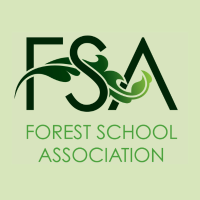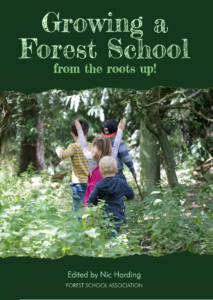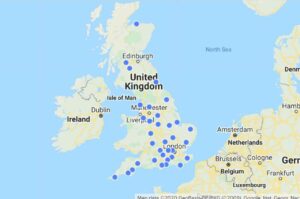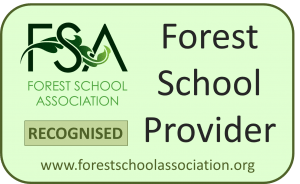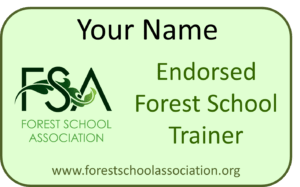Forest School leaders should have an understanding of the ecological structures of woodlands and be able to identify a range of flora and fauna. They understand the importance of flora and fauna identification for the Forest School Programme and have an understanding of the management of woodlands as a sustainable learning environment.
Ecology
Knowledge of the ecology of woodlands is essential for any Forest School leader. Ecology derives its name from ‘oikos’ which literally means household and the study of all the interactions in that household. The interactions in a woodland are fascinating, and while FS leaders are not expected to be professional ecologists, the desire to learn about the complex interactions between species and their woodland environment; soils, rocks, land, light, temperature, seasons etc, provide rich learning. It is the interactions between energy flows and the cycling of nutrients that provide the basis for any ecosystem. In woodlands it is often the interaction between fungi, plants and animals – all dictated by light, soil and temperature that are amazing. While animals may occupy the same area in a woodland – blue tits and squirrels for example occupying the tree canopy – each species has its own ‘role’ or niche that makes the woodland a dynamic habitat. Of course this can change over time and the way humans interact and manage a woodland can drastically change the ecology of a wood – for good or bad (in biodiversity terms). Many of todays problems associated with our UK woods are down to limited understanding of woodland ecology, lack of sensitive management (leaving overstood coppice for example can restrict light and reduce the biodiversity of ground flora) and introduction of species that can severely upset the balance and disrupt the ecology (grey squirrels, for example, can have a huge effect on trees – ‘topping’ them out by ring barking can kill canopy trees). This section of the wiki will delve into woodland ecology in more detail and how we, as Forest School communities, can support the ecology of a woodland.
Habitat/woodland surveying and management
The myForest service was developed by the Sylva Foundation as an online platform to support sustainable forest management by woodland owners and managers because the majority (72%) of woodlands in Britain are in private hands and about half of these are thought to be under- or un-managed – learn more
myForest for Educators – Register here
- A slimmed down version of the main woodland owner account,
- specifically designed for providers of woodland education e.g. Forest School leaders
- allows you to create a simple management plan for your woodland setting
- builds your knowledge of sustainable woodland management
Mapping
- map your woodlands using simple tools
- map features, such as ponds, rivers, woodland rides and access points
- calculate the area of your woodland compartments
- create, download and print maps maps to inform management planning and operations
- import and export your mapping data
Management planning
- create management plans which follow Forestry Commission England’s template
- create a Plan of Operations from your inventory data which can provide you with your Felling Licences
- plans includes individual compartment inventory information
- plans are downloaded as PDF files for printing, emailing and back up and can be updated at any point
Woodland inventory
- carry out an inventory of the trees growing in your woodland, including species, age and size
- store information on habitat types
- upload and store photographs of each woodland subcompartment
Landscape/Woodland history
Woodlands and landscape have gone hand in hand since life evolved from the ancient sea and moved on to land to eventually reach its ‘climax’ habitat – which in the UK comprised to a large extent of woodland. After the last ice age, and many scientists say we are currently in an ice age!, the land in the UK, before humans appeared, was a mosaic of woodlands, grasslands and wetlands. Woodlands varied in their composition around the UK – depending on geology and climate.
There were 5 climax ‘wildwood types’ in the UK;
southern lowland britain was dominated by Lime trees; while further north and in the west it was Oak and Hazel; most of Ireland and South-West Wales had Elm and Hazel ; and towards the north, Eastern Scotland saw Scots Pine and in the west Birch was dominant. Of course it was more complex than this but helps simplify our woodland types, as was, at the time humans began to occupy the land, moving up from the south over 6000 years ago .
The landscape then started to change more rapidly and over the thousands of years of human communities living in and next to woodlands. This knowledge of our interactions – mostly in order to survive, meet our needs and increasingly to prosper economically has informed us how our ‘management’ of woods impacts on woodland wildlife and ecology.
For an excellent account of the UK landscape history and the role of woodlands in this see Oliver Rackham’s “The History of the Countryside – the full fascinating story of Britain’s landscape” (Dent, 1990).
Species identification
Accurate identification and good knowledge of local Forest School site flora and fauna is a really important aspect for the Forest School Leader for many reasons such as:
- Protected species and their habitat
- Health & Safety such as poisonous plants and sudden limb drop
- Sustainable use of suitable plants and trees for crafts and fire resources
- Knowledge of species which provide good spaces for safe play and play structures
- Knowledge and understanding to stimulate curiosity, to teach children about ecology and the natural world around them and to know the importance of sustainability
- It`s a whole potentially new magical world for every participant at Forest School – including the adults!
It is important to understand the process of being able to identify according to specific identifying traits in accurate flora and fauna identification.
